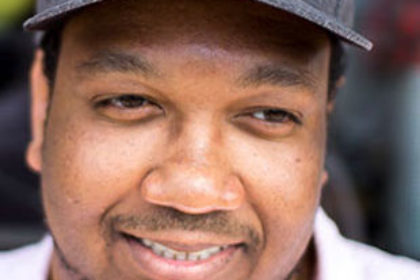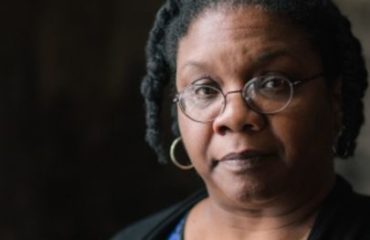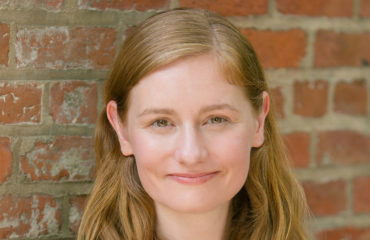Edward Salem is a poet who hasn’t lost his sense of humor. “Palestinians,” he shares in our int...

OCTOBER INTERVIEW with EDWARD SALEM

SEPTEMBER INTERVIEW with LIZA HUDOCK
Addiction, death, and loss are everywhere in Liza Hudock’s debut collection, Reveille (released...

SEPTEMBER INTERVIEW with Julia Thacker
Julia Thacker’s debut collection To Wildness was recently awarded the Anthony Hecht prize...

JUNE INTERVIEW WITH STEVEN ESPADA DAWSON
Late to the Search Party is the debut collection of Steven Espada Dawson, exploring the individ...

MAY INTERVIEW WITH SOPHIA TERAZAWA
When readers first meet the narrator of Sophia Terazawa’s novel, Tetra Nova, published by Deep ...
INTERVIEW WITH Tommye Blount

Born and raised in Detroit, Tommye Blount now calls Novi home. A graduate from Warren Wilson College’s MFA Program for Writers, he has been the recipient of fellowships and scholarships from Cave Canem and the Bread Loaf Writers’ Conference. His work can be found in various journals and anthologies. His full-length collection is forthcoming from Four Way Books.
FWR: How do you protect your time and foster your writing?
TB: Like many poets now, and throughout history, I work a demanding weekday job, so writing can sometimes feel nearly impossible for me. With that said, I do dedicate early Saturday and Sunday mornings (or any off days) as “writing” time. Writing is in quotes, because in these sessions, I make no promises to myself that I have to write anything at all—and, to be frank, sometimes I don’t write. There may be times where I do nothing but read essays or books by other poets or fiction writers. (Oh! One of my obsessions as of late are essays on fashion—have you read The Battle of Versailles by Robin Givhan?) If you were to pop in on me, you might even see me looking at YouTube videos of other artists—either performing or talking about their disciplines. Where I am getting at is this: the act of writing for me encompasses a lot more than the physical act of writing.
Right now, I am in New York for a theater run—something I do often. Yes, I am gaga over musicals and plays, and get gooseflesh anytime someone starts talking about Audra McDonald, but all of this too is a part of my process. Watching other artistic disciplines feeds me. Not so much the subject matter of their work—although that is fair game for me as well—but I am more interested in their materials. For the past couple of years, I have been going to Stratford, Ontario, home of the Stratford Shakespearean Festival. Here, the plays and musicals are performed in repertory—so many shows are going on at once. You will see one actor playing two, or three, different roles in different shows. I love this, because to me, and my poet brain, it always leads me to rhyme and the shapes of rhyme. When I am watching occurrences like this happening, something seemingly minor to most of the audience, I am thinking how can I translate this into a poem. Of course, I can’t ever pull it off when I mean to pull it off—I’m too slow for that. Ha! It takes a while for the idea to sink into my body and, it always seems, out of nowhere I pull it off without thinking about it—or maybe I am thinking about it? I don’t know.
FWR: I’m struck by this image of actors playing multiple rows in multiple shows. It makes me think of the moving between forms and personas, how the self can be fractured and recast (in a poem like “The Bug”, for instance).
TB: Bifurcation is a frequent kind of transformation that takes place in my work. Many of my poems are in first person singular, so I often challenge myself to see what happens when that gets split off into two entities sharing the same space. “The Bug” complicates the first person by allowing that other man to speak through him halfway through the poem. What better way to explore a kind of love than through possession? And going back to your mention of form—in my chapbook there are many received forms that resist the conventions of those forms. These too act as a kind of fracture and recast, but moreover it goes back to my love of bodily transformation and how that allows me to divorce a body from its intent.
FWR: Can you speak further to finding inspiration in different art forms? (and considering those explorations part of the act of writing!)
TB: Of course, as writers we should first be lovers of reading, but other art forms too have much to teach us. In 2017, I was one of 18 recipients of a Kresge Arts in Detroit fellowship. Each year, there are two groups of nine artists chosen from two rotating categories. This time around the categories are Literary and Visual Arts, but everyone is doing all kinds of work: art criticism, sculpture, mural painting, collage, quilting, dance, and more. The fellowship comes with a pretty large amount of money with no-strings-attached, but that has not been the highlight of my tenure. The best part has been getting to dig into the work of the other fellows and, in one case, getting to sit in on a session. I just think writers limit themselves if they are only looking toward their own discipline for techniques or new ways of thinking about stuff. The dancer/choreographer Bill T. Jones teaches me just as much as the poet Carl Phillips.
FWR: I’m drawn to the way you play with syntax in many of your poems (“The Black Umbrella”, for example). It seems to not only allow for a reveal and revision of information, but also to suggest greater possibility in the memory of a poem. Along the lines of structure, I’d love to hear what you were thinking while arranging this manuscript. How did you decide when to echo back to a previous poem or image, or when to expand upon an idea?
TB: Matthew Olzmann, the killer poet and a dear friend of mine, was—thank goodness—my editor for What Are We Not For. The manuscript I submitted to Bull City Press, structurally speaking, was close to the final arrangement, but Matthew encouraged me to meddle with the linearity of the structure. I mean, the narrative of the collection is pretty linear right now, but some of that echoing you are hearing is due to Matt’s suggestions. One of the most obvious examples is what happened with what I call my doggie suite of poems—poems for which you all graciously gave a first home: “Bareback Aubade with the Dog,” “And the Dog Comes Back,” “The Runts,” and “Lycanthropy.” In my mind, that was the order of these poems and that is how they appeared in the initial manuscript. Matthew and I decided to break up the suite and rearrange them, so that they call out to each other across the book while informing the poems immediately around them.
Another choice I should talk about is where the title poem falls in the collection—it’s the penultimate poem. Matt deserves credit for this choice as well. At first, I had this poem so obviously seated at the center of the book. Poems, when putting a manuscript together, are really fractals building toward a single larger version of themselves—that’s what this chapbook is up to as well. Just as each poem is aware of where its volta sits, so too does this collection. “What Are We Not For,” the title poem, acts as a turn of revelation in the collection. “What are we not for,” that phrase, because it is the title of the book, gets teased out for much of the book—it is at once: a dare; a mandate; a question; a resignation. It is not until the penultimate poem that the collection realizes what it has been up to all along.
FWR: Speakers are bodied and performed in a way that responds to assumptions about race and gender (“the black boy/lurking in our imagination” from “There is Always a Face to Tend To”). Yet, there is also this movement away from the body, both as a means of protection (“Our bodies are museums/ Our bodies are objects in a museum A thing a thing” from “The Lynching of Frank Embree”) and a refusal to be limited to the body’s confines. I was wondering if you could speak a bit to this.
TB: The bodies in these poems are always in danger—or at least I mean them to appear that way. These gestures of transformation, or the botched attempts at transformations, are markers of a larger exploration (I think—how can one really be sure) that my work as a whole seeks. Transformation, to my mind, allows me the space to divorce a given body from its intent. My poems mean to explore the breakdown between a body’s intent and the gesture that intent manifests. It’s why the poems in this collection are interested in race, gender, and sexuality. Well—all of that and the fact that I am a Black gay man negotiating all of this stuff. In the case of Frank Embree, I mean the speaker to be victim and assailant at once. He, and his kind, has suffered at the hands of men who look like Frank Embree, so he is enraged. He is also troubled by this rage, because it is, also, directed to himself—inheritor of Embree’s body. I like to think that no one, not even me as creator, is protected in my poems.
FWR: When you say, “the bodies in these poems are always in danger… transformation, to my mind, allows me the space to divorce a given body from its intent” —firstly, I love this. And, I think it speaks to two correlated ideas, the first being that destruction can allow for transformation (the cliché of the butterfly and all that), even if that transformation is happening in the witness. The second thing I think of is the push between identity and the gesture, how performance might codify identity— for better or worse.
TB: When I say transformation allows me the space to divorce a given body from its intent, I’m thinking in terms of how, at last, a body can reveal itself to be meant for another way of being than one those outside of that body anticipate.
As a Black gay man living in Michigan, I often get the silly phrase “You don’t read as gay.” When, in my mind, I am so very gay. There is a disconnect happening between my choreography and how my postures are being seen. And look at all of the police murders of Black folks that are happening: blackness being seen as a threat that must be stomped out. Little Trayvon in his hoodie being gunned down by Zimmerman, because he thought the boy looked suspicious. Or, in my neck of the woods, Renisha McBride, a Black woman shot while knocking on a door for help. It should not be a surprise that my poems want to sit inside of that disconnect between gesture and intent.
FWR: The play between sensuality and sexuality, particularly with regards to expressions of masculinity/manhood, is threaded throughout the text. I see the movement as poems ease from inertia (the experience or suggestion of pleasure) to urgency (wanting, acting on sex). I read it as a desire to reclaim space, in spite of the stereotypes and violence associated with having a “body/dark and big as history”.
TB: Yeah, okay, sure: that is one way one might look at that patterning—it is there of course. But, I must say, I’m not sure if that reclamation of a Black space, or that redefinition of some view of Blackness, was at the fore in my mind. I’m probably repeating myself, but I’m really interested in this breakdown between intent and the gesture that intent brings forth. This misfiring between intent and gesture is how we arrive, often, at points of pleasure and violence. So, yes, I am thinking about this Black body I have inherited, but I am also thinking about this gay body I have inherited at the same time. This is why, for example, right after “The Lynching of Frank Embree” there is “Aaron McKinney Cleans His Magnum”—a poem around Matthew Shepard (whose death scared me further into the closet in undergrad). And in the reference to Shepard’s murder you are to hear echoes of Pinocchio (another “wicked” boy) and his plight. This is not to say that the book is an erasure of Blackness—you are right; it is there—but it is complicated a bit (or at least I mean it to be).
FWR: When you say “he [the speaker] is troubled by this rage”, is there also the element of society’s denial or suppression of Black anger? An awareness that whiteness expects a Black body to hold his/her feelings without release?
TB: That self-inflicted rage of which I speak comes from a kind of shame. The conversation that is happening in this poem has to do with the speaker and his relation to his own black maleness—and the inherent history with which that comes. Any conversations about the role of whiteness is in the periphery or gets superseded by what is happening between the speaker and the image of Frank Embree. That is why, for example, the admission “yes, white” appears in parenthesis; why the speaker’s thumb tip print sits over the image of the lyncher’s brim. The speaker in the poem is challenging what he can say and do and in what space—the boundary between the room of the gallery and the private room in which a porn film is playing is fractured.
FWR: To shift gears, is there a poem you love to teach or share?
TB: C. Dale Young introduced me to Brigit Pegeen Kelly’s book The Orchard while at Warren Wilson. Now, I am not going to lie, I bought that book a couple of years before getting into Warren Wilson and it sat unread on my bookshelf. (Bad poet, I know.) Let me tell you: when I finally read that book for the first time it unhooked something in me. It’s hard to just tell people to only read one BPK poem, so I often suggest they read The Orchard, but then I tell them to pay close attention to the title poem of that book. The images in all of her poems, but in that poem especially, fidget; they refuse to remain static on the page. Specifically, she does this with similes that I always have a hard time explaining to people, because they think I am talking mixed metaphors or something. (It’s not—I swear!) Watch out for the fucking dog in that poem! Just in the first few lines, the dog is said to be like a horse. Then, without warning, the poem calls it “the horse.” I hate poems, including mine, when there are gestures toward figuration that are only a means of comparison or ornamentation. No, figuration should and can do more. In “The Orchard,” and many other of BPK’s poems, figuration is how the poems keep pushing forward. I was so sad when I heard she passed away. What a loss.
FWR: Thinking ahead to when Four Way Books will publish your full length (and congratulations!) and considering what you say about the ordering of your poems, I was wondering if you might speak to what the process is like moving from a chapbook to a full-length manuscript. Will you be pulling many (or any!) poems from What Are We Not For over? How does the process of revisiting those poems change the way you see them working in conversation with each other?
TB: Thanks—it’s all exciting and scary for me at the same time. Actually, that is my everyday temperament; excited and scared. Ha! Martha Rhodes has been such a huge champion of my work and then there I am like, “Who? Me?” It’s still very early in the process, but I am told things are going to get a little crazy in the next few months for me. At first, I did not want to pull anything from the chapbook, but as the concept for the new book is working itself out, I am seeing that a few poems will be making cameos. Then there are these new poems that will totally recast (there is that word again) those old poems in new ways. That is probably my favorite part of this process is seeing how the old poems gossip with the new poems.

SEPTEMBER INTERVIEW with Julia Thacker
Julia Thacker’s debut collection To Wildness was recently awarded the Anthony Hecht prize...

FEBRUARY MONTHLY: INTERVIEW with CLAIRE HOPPLE
From the first sentence of Claire Hopple’s latest novel, Take It Personally, you know you’re in...
JUNE MONTHLY: In Solidarity with the Palestinian People
Nearly a year after the October 7 Hamas terrorist attack and Israel’s subsequent escalati...

ECOPOETRY FROM JAPAN with Ryoichi Wago and Rumiko Kora, trans. Judy Halebsky & Ayako Takahashi
TRANSLATOR’S INTRODUCTION by Judy Halebsky THREE POEMS by Rumiko Kora, trans. Judy Halebs...

INTRODUCTION TO KORA RUMIKO & WAGO RYOICHI by Judy Halebsky
THREE POEMS by Rumiko Kora, trans. Judy Halebsky & Ayako Takahashi FIVE POEMS by Ryoichi Wa...

